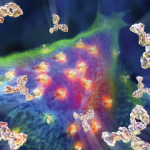ACPA Testing
At the time the 1998 paper from van Venrooij’s group was published, RF was the only serological test generally used diagnostically for RA. An earlier test based on APF positivity was difficult to perform for several logistical reasons, and it was not routinely used.8 But the recognition of ACPAs opened the door to what would eventually become a critically important test.
The first tests developed to assess ACPAs had excellent specificity but relatively poor sensitivity. Later tests used a cyclic version of a citrullinated peptide instead of earlier linear forms.7 Dr. Fox explains, “The cyclic citrullinated peptide is really an artificial sort of protein-like molecule that is created for this test that has several different determinants on it that ACPAs can recognize. Therefore, it can pick up ACPAs of different specificities. There is no protein in the body that is constructed exactly that way—it’s an artificial test protein that allows detection of the antibodies that we are interested in.” Thus, the cyclic citrullinated peptide (CCP) test was born, which had much improved sensitivity. In the literature, “ACPAs” and “anti-CCP antibodies” are usually used synonymously.
The current gold standard for testing is a modified form of this original test CCP test. Several types of test configurations have been developed, with some recognizing both IgG and IgA ACPAs. The anti-CCP test was included as part of ACR rheumatoid arthritis guidelines in 2010.7
Speaking of today’s test, Dr. Fox notes, “It does help us be sure that a patient with otherwise undifferentiated inflammatory arthritis really does have RA. It’s more useful diagnostically than any other blood test that we have; for example, RF is a very nonspecific test.” He also adds that it can help alert clinicians to patients who may be more prone to severe disease and early joint damage, due to its association with loss of cartilage and bone. “It means that we really shouldn’t allow the disease to stay active. We should treat it very diligently until it’s at low disease activity or remission, and we should try to get to that point efficiently.”
Currently, most people don’t receive an anti-CCP test unless suggestive symptoms have already begun. However, in some cases, a patient may come back with a positive anti-CCP test without symptoms. Dr. Holers notes there is currently no consensus in the field as to how to handle such patients: “There is a variable approach to this issue. Some people will say come back when you have symptoms; some people will treat, especially if they have the sense that some of the vague complaints that patients almost always have might be related to early arthritis or intermittent inflammation.”

